Enhancing Light Harvesting in Dye-Sensitized Solar Cells through Mesoporous Silica Nanoparticle-Mediated Diffuse Scattering Back Reflectors
Abstract
:1. Introduction
2. Materials and Methods
3. Results
3.1. MSNs Characterization
3.2. Photovoltaic Measurements
3.3. Charge Transport Measurements
4. Discussion
5. Conclusions
Supplementary Materials
Author Contributions
Funding
Data Availability Statement
Acknowledgments
Conflicts of Interest
References
- Intergovernmental Panel on Climate Change; Working Group I; Masson-Delmotte, V.R. Climate Change 2021: The Physical Science Basis: The Working Group I Contribution to the Sixth Assessment Report of the Intergovernmental Panel on Climate Change; IPCC (Intergovernmental Panel on Climate Change): Geneva, Switzerland, 2021. [Google Scholar]
- Intergovernmental Panel on Climate Change; Working Group III. Climate Change 2022: Mitigation of Climate Change: The Working Group III Contribution to the Sixth Assessment Report of the Intergovernmental Panel on Climate Change; IPCC (Intergovernmental Panel on Climate Change): Geneva, Switzerland, 2022. [Google Scholar]
- Weerasinghe, H.C.; Huang, F.Z.; Cheng, Y.B. Fabrication of flexible dye sensitized solar cells on plastic substrates. Nano Energy 2013, 2, 174–189. [Google Scholar] [CrossRef]
- Parisi, M.L.; Maranghi, S.; Basosi, R. The evolution of the dye sensitized solar cells from Gratzel prototype to up-scaled solar applications: A life cycle assessment approach. Renew. Sustain. Energy Rev. 2014, 39, 124–138. [Google Scholar] [CrossRef]
- Munoz-Garcia, A.B.; Benesperi, I.; Boschloo, G.; Concepcion, J.J.; Delcamp, J.H.; Gibson, E.A.; Meyer, G.J.; Pavone, M.; Pettersson, H.; Hagfeldt, A.; et al. Dye-sensitized solar cells strike back. Chem. Soc. Rev. 2021, 50, 12450–12550. [Google Scholar] [CrossRef] [PubMed]
- Haridas, R.; Velore, J.; Pradhan, S.C.; Vindhyasarumi, A.; Yoosaf, K.; Soman, S.; Unni, K.N.N.; Ajayaghosh, A. Indoor light-harvesting dye-sensitized solar cells surpassing 30% efficiency without co-sensitizers. Mater. Adv. 2021, 2, 7773–7787. [Google Scholar] [CrossRef]
- Li, G.; Sheng, L.; Li, T.Y.; Hu, J.; Li, P.W.; Wang, K.Y. Engineering flexible dye-sensitized solar cells for portable electronics. Sol. Energy 2019, 177, 80–98. [Google Scholar] [CrossRef]
- Oregan, B.; Gratzel, M. A Low-Cost, High-Efficiency Solar-Cell Based on Dye-Sensitized Colloidal Tio2 Films. Nature 1991, 353, 737–740. [Google Scholar] [CrossRef]
- Gong, J.W.; Sumathy, K.; Qiao, Q.Q.; Zhou, Z.P. Review on dye-sensitized solar cells (DSSCs): Advanced techniques and research trends. Renew. Sustain. Energy Rev. 2017, 68, 234–246. [Google Scholar] [CrossRef]
- Ramasamy, P.; Kim, J. Combined plasmonic and upconversion rear reflectors for efficient dye-sensitized solar cells. Chem. Commun. 2014, 50, 879–881. [Google Scholar] [CrossRef]
- Li, W.; Tan, X.Y.; Zhu, J.L.; Xiang, P.; Xiao, T.; Tian, L.H.; Yang, A.B.; Wang, M.; Chen, X.B. Broadband antireflective and superhydrophobic coatings for solar cells. Mater. Today Energy 2019, 12, 348–355. [Google Scholar] [CrossRef]
- Fathima, M.I.; Wilson, K.S.J. Efficiency Enhancement in Dye Sensitized Solar Cell Using 1D Photonic Crystal. Silicon 2022, 14, 4283–4289. [Google Scholar] [CrossRef]
- Lee, Y.L.; Chen, C.L.; Chong, L.W.; Chen, C.H.; Liu, Y.F.; Chi, C.F. A platinum counter electrode with high electrochemical activity and high transparency for dye-sensitized solar cells. Electrochem. Commun. 2010, 12, 1662–1665. [Google Scholar] [CrossRef]
- Lee, B.; Hwang, D.K.; Guo, P.J.; Ho, S.T.; Buchholtz, D.B.; Wang, C.Y.; Chang, R.P.H. Materials, Interfaces, and Photon Confinement in Dye-Sensitized Solar Cells. J. Phys. Chem. B 2010, 114, 14582–14591. [Google Scholar] [CrossRef] [PubMed]
- Liu, W.; Ma, H.L.; Walsh, A. Advance in photonic crystal solar cells. Renew. Sustain. Energy Rev. 2019, 116, 109436. [Google Scholar] [CrossRef]
- Ibrahim, I.; Lim, H.N.; Wan, N.W.K.; Huang, N.M.; Lim, S.P.; Busayaporn, W.; Nakajima, H. Plasmonic silver sandwich structured photoanode and reflective counter electrode enhancing power conversion efficiency of dye-sensitized solar cell. Sol. Energy 2021, 215, 403–409. [Google Scholar] [CrossRef]
- Kaur, N.; Syed, F.M.; Fina, J.; Lai, C.Y.; Radu, D.R. Ag Reflectors: An Effective Approach to Improve Light Harvesting in Dye Sensitized Solar Cells. IEEE J. Photovolt. 2023, 13, 250–253. [Google Scholar] [CrossRef]
- Kaur, N.; Oyon, S.A.; Lai, C.Y.; Radu, D.R. From reflection to absorption: Improving light harvesting of dye sensitized solar cells with Cu nanowires as reflectors. Opt. Mater. 2023, 142, 114074. [Google Scholar] [CrossRef]
- Chen, H.W.; Chiang, Y.D.; Kung, C.W.; Sakai, N.; Ikegami, M.; Yamauchi, Y.; Wu, K.C.W.; Miyasaka, T.; Ho, K.C. Highly efficient plastic-based quasi-solid-state dye-sensitized solar cells with light-harvesting mesoporous silica nanoparticles gel-electrolyte. J. Power Sources 2014, 245, 411–417. [Google Scholar] [CrossRef]
- Tanvi; Mahajan, A.; Bedi, R.K.; Kumar, S.; Saxena, V.; Aswal, D.K. Efficiency enhancement in dye sensitized solar cells using dual function mesoporous silica as scatterer and back recombination inhibitor. Chem. Phys. Lett. 2016, 658, 276–281. [Google Scholar] [CrossRef]
- Ryu, J.; Yun, J.; Lee, J.; Lee, K.; Jang, J. Hierarchical mesoporous silica nanoparticles as superb light scattering materials. Chem. Commun. 2016, 52, 2165–2168. [Google Scholar] [CrossRef]
- Zhang, Q.F.; Myers, D.; Lan, J.L.; Jenekhe, S.A.; Cao, G.Z. Applications of light scattering in dye-sensitized solar cells. Phys. Chem. Chem. Phys. 2012, 14, 14982–14998. [Google Scholar] [CrossRef]
- Yu, I.G.; Kim, Y.J.; Kim, H.J.; Lee, C.; Lee, W.I. Size-dependent light-scattering effects of nanoporous TiO2 spheres in dye-sensitized solar cells. J. Mater. Chem. 2011, 21, 532–538. [Google Scholar] [CrossRef]
- Wang, M.; Ye, X.Y.; Wan, X.; Liu, Y.T.; Xie, X.M. Brilliant white polystyrene microsphere film as a diffuse back reflector for solar cells. Mater. Lett. 2015, 148, 122–125. [Google Scholar] [CrossRef]
- Ito, S.; Murakami, T.N.; Comte, P.; Liska, P.; Gratzel, C.; Nazeeruddin, M.K.; Gratzel, M. Fabrication of thin film dye sensitized solar cells with solar to electric power conversion efficiency over 10%. Thin Solid Film. 2008, 516, 4613–4619. [Google Scholar] [CrossRef]
- Zhang, Q.F.; Cao, G.Z. Hierarchically structured photoelectrodes for dye-sensitized solar cells. J. Mater. Chem. 2011, 21, 6769–6774. [Google Scholar] [CrossRef]
- Barugkin, C.; Beck, F.J.; Catchpole, K.R. Diffuse reflectors for improving light management in solar cells: A review and outlook. J. Opt. 2017, 19, 014001. [Google Scholar] [CrossRef]
- Fu, J.K.; Wang, Y.; Zhu, Y.C. Broadband and high diffuse reflectivity of hollow mesoporous silica nanospheres and their UV light shielding ability for light-labile peroxides. Mater. Lett. 2015, 153, 89–91. [Google Scholar] [CrossRef]
- Usami, A. Theoretical simulations of optical confinement in dye-sensitized nanocrystalline solar cells. Sol. Energy Mater. Sol. Cells 2000, 64, 73–83. [Google Scholar] [CrossRef]
- Fu, S.M.; Lai, Y.C.; Tseng, C.W.; Yan, S.L.; Zhong, Y.K.; Shen, C.H.; Shieh, J.M.; Li, Y.R.; Cheng, H.C.; Chi, G.C.; et al. Approaching conversion limit with all-dielectric solar cell reflectors. Opt. Express 2015, 23, A106–A117. [Google Scholar] [CrossRef]
- Freitag, M.; Teuscher, J.; Saygili, Y.; Zhang, X.; Giordano, F.; Liska, P.; Hua, J.; Zakeeruddin, S.M.; Moser, J.E.; Gratzel, M.; et al. Dye-sensitized solar cells for efficient power generation under ambient lighting. Nat. Photonics 2017, 11, 372–378. [Google Scholar] [CrossRef]
- Lai, C.Y.; Trewyn, B.G.; Jeftinija, D.M.; Jeftinija, K.; Xu, S.; Jeftinija, S.; Lin, V.S.Y. A mesoporous silica nanosphere-based carrier system with chemically removable CdS nanoparticle caps for stimuli-responsive controlled release of neurotransmitters and drug molecules. J. Am. Chem. Soc. 2003, 125, 4451–4459. [Google Scholar] [CrossRef]
- Na, H.; Venedicto, M.; Chang, C.Y.; Carrier, J.; Lai, C.Y. Infrared-Activated Bactericide: Rhenium Disulfide (ReS2)-Functionalized Mesoporous Silica Nanoparticles. ACS Appl. Bio Mater. 2023, 6, 1577–1585. [Google Scholar] [CrossRef] [PubMed]
- Venedicto, M.; Carrier, J.; Na, H.; Chang, C.Y.; Radu, D.R.; Lai, C.Y. Disulfide-Modified Mesoporous Silica Nanoparticles for Biomedical Applications. Crystals 2023, 13, 1067. [Google Scholar] [CrossRef]
- Lu, C.; Yang, H.M.; Wang, J.; Tan, Q.; Fu, L.J. Utilization of iron tailings to prepare high -surface area mesoporous silica materials. Sci. Total Environ. 2020, 736, 139483. [Google Scholar] [CrossRef] [PubMed]
- Nairi, V.; Medda, S.; Piludu, M.; Casula, M.F.; Vallet-Regi, M.; Monduzzi, M.; Salis, A. Interactions between bovine serum albumin and mesoporous silica nanoparticles functionalized with biopolymers. Chem. Eng. J. 2018, 340, 42–50. [Google Scholar] [CrossRef]
- Olabisi, O.; Adewale, K. Handbook of Thermoplastics, 2nd ed.; CRC Press, Taylor & Francis Group: Boca Raton, FL, USA, 2016; Volume xvii, 994p. [Google Scholar]
- Wen, P.H.; Han, Y.F.; Zhao, W.X. Influence of TiO2 Nanocrystals Fabricating Dye-Sensitized Solar Cell on the Absorption Spectra of N719 Sensitizer. Int. J. Photoenergy 2012, 2012, 906198. [Google Scholar] [CrossRef]
- Nunomura, S.; Minowa, A.; Sai, H.; Kondo, M. Mie scattering enhanced near-infrared light response of thin-film silicon solar cells. Appl. Phys. Lett. 2010, 97, 063507. [Google Scholar] [CrossRef]
- Fielding, L.A.; Mykhaylyk, O.O.; Schmid, A.; Pontoni, D.; Armes, S.P.; Fowler, P.W. Visible Mie Scattering from Hollow Silica Particles with Particulate Shells. Chem. Mater. 2014, 26, 1270–1277. [Google Scholar] [CrossRef]
- Koo, H.J.; Park, J.; Yoo, B.; Yoo, K.; Kim, K.; Park, N.G. Size-dependent scattering efficiency in dye-sensitized solar cell. Inorg. Chim. Acta 2008, 361, 677–683. [Google Scholar] [CrossRef]
- Lu, H.; Huang, M.; Shen, K.S.; Zhang, J.; Xia, S.Q.; Dong, C.; Xiong, Z.G.; Zhu, T.; Wu, D.P.; Zhang, B.; et al. Enhanced Diffuse Reflectance and Microstructure Properties of Hybrid Titanium Dioxide Nanocomposite Coating. Nanoscale Res. Lett. 2018, 13, 328. [Google Scholar] [CrossRef]
- Sanchezgil, J.A.; Nietovesperinas, M. Light-Scattering from Random Rough Dielectric Surfaces. J. Opt. Soc. Am. A-Opt. Image Sci. Vis. 1991, 8, 1270–1286. [Google Scholar] [CrossRef]
- Maradudin, A.A.; Mendez, E.R. Light scattering from randomly rough surfaces. Sci. Prog. 2007, 90, 161–221. [Google Scholar] [CrossRef] [PubMed]
- Wiersma, D.S. Disordered photonics. Nat. Photonics 2013, 7, 188–196. [Google Scholar] [CrossRef]
- van de Lagemaat, J.; Frank, A.J. Effect of the surface-state distribution on electron transport in dye-sensitized TiO2 solar cells: Nonlinear electron-transport kinetics. J. Phys. Chem. B 2000, 104, 4292–4294. [Google Scholar] [CrossRef]
- Bisquert, J. Theory of the impedance of electron diffusion and recombination in a thin layer. J. Phys. Chem. B 2002, 106, 325–333. [Google Scholar] [CrossRef]
- Wang, Q.; Moser, J.E.; Gratzel, M. Electrochemical impedance spectroscopic analysis of dye-sensitized solar cells. J. Phys. Chem. B 2005, 109, 14945–14953. [Google Scholar] [CrossRef]
- Fabregat-Santiago, F.; Bisquert, J.; Palomares, E.; Otero, L.; Kuang, D.B.; Zakeeruddin, S.M.; Gratzel, M. Correlation between photovoltaic performance and impedance spectroscopy of dye-sensitized solar cells based on ionic liquids. J. Phys. Chem. C 2007, 111, 6550–6560. [Google Scholar] [CrossRef]
- Andrade, L.; Sousa, J.; Ribeiro, H.A.; Mendes, A. Phenomenological modeling of dye-sensitized solar cells under transient conditions. Sol. Energy 2011, 85, 781–793. [Google Scholar] [CrossRef]
- Sarker, S.; Ahammad, A.J.S.; Seo, H.W.; Kim, D.M. Electrochemical Impedance Spectra of Dye-Sensitized Solar Cells: Fundamentals and Spreadsheet Calculation. Int. J. Photoenergy 2014, 2014, 851705. [Google Scholar] [CrossRef]
- Zdyb, A.; Krawczak, E. Organic Dyes in Dye-Sensitized Solar Cells Featuring Back Reflector. Energies 2021, 14, 5529. [Google Scholar] [CrossRef]
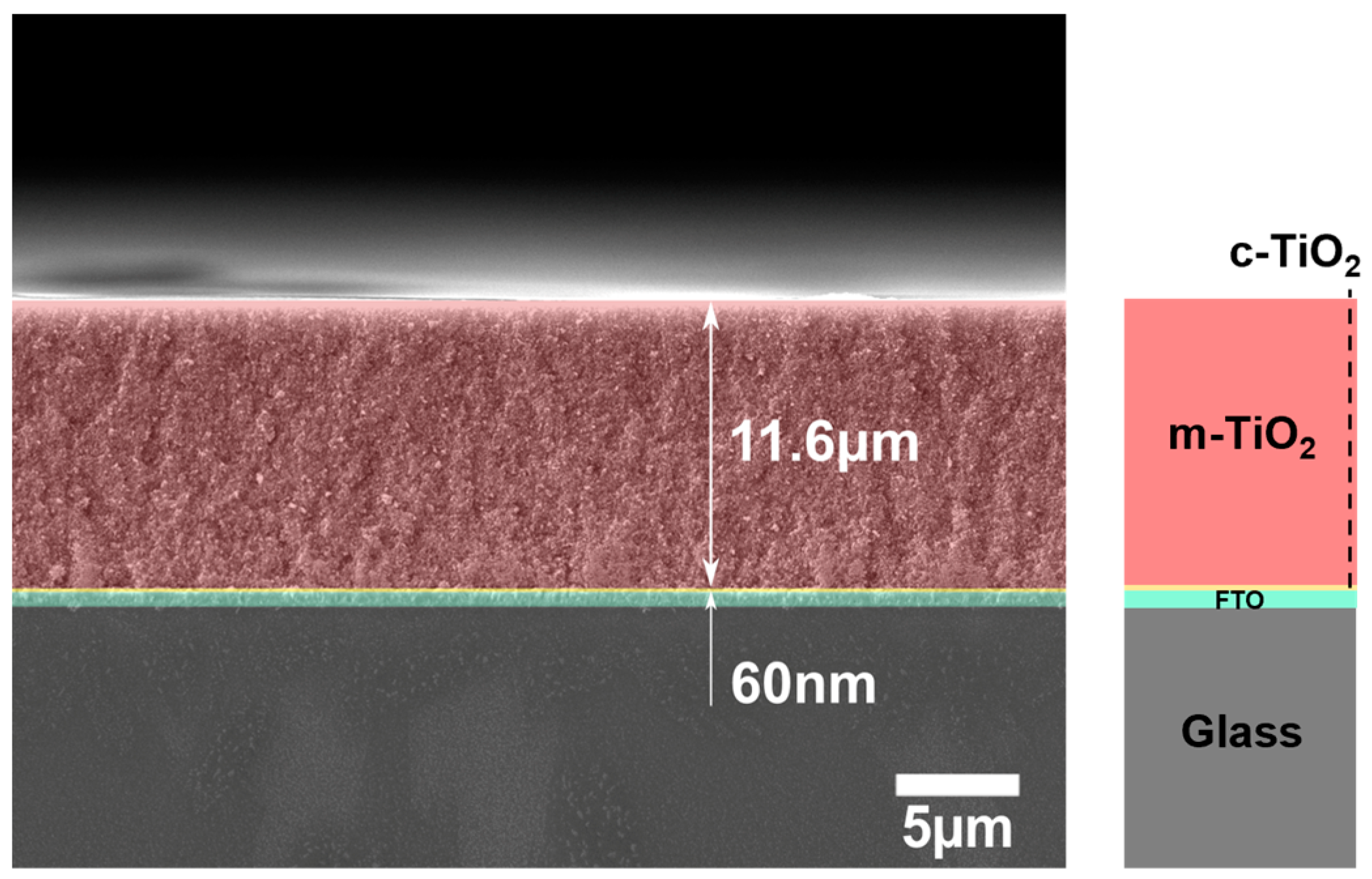

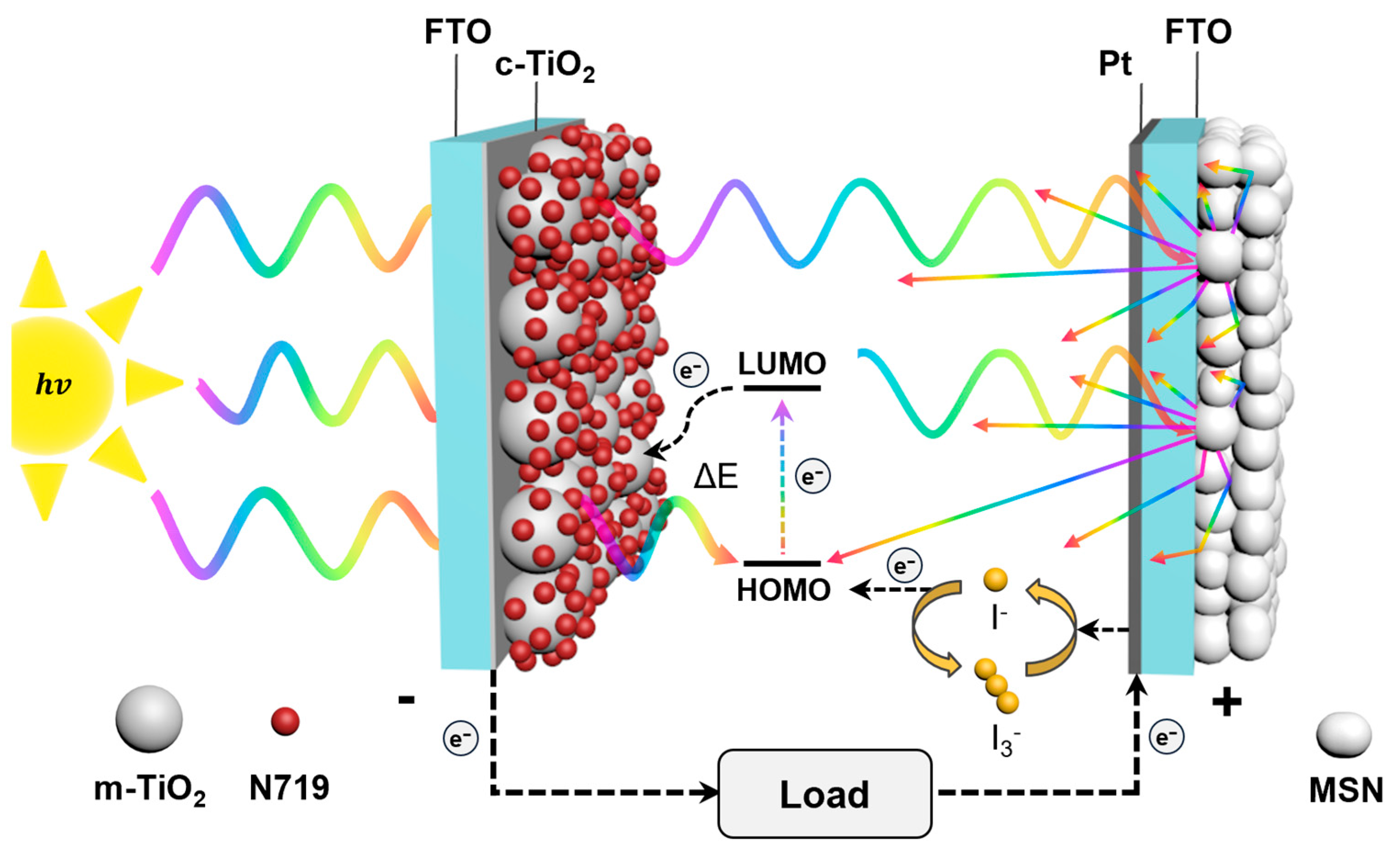
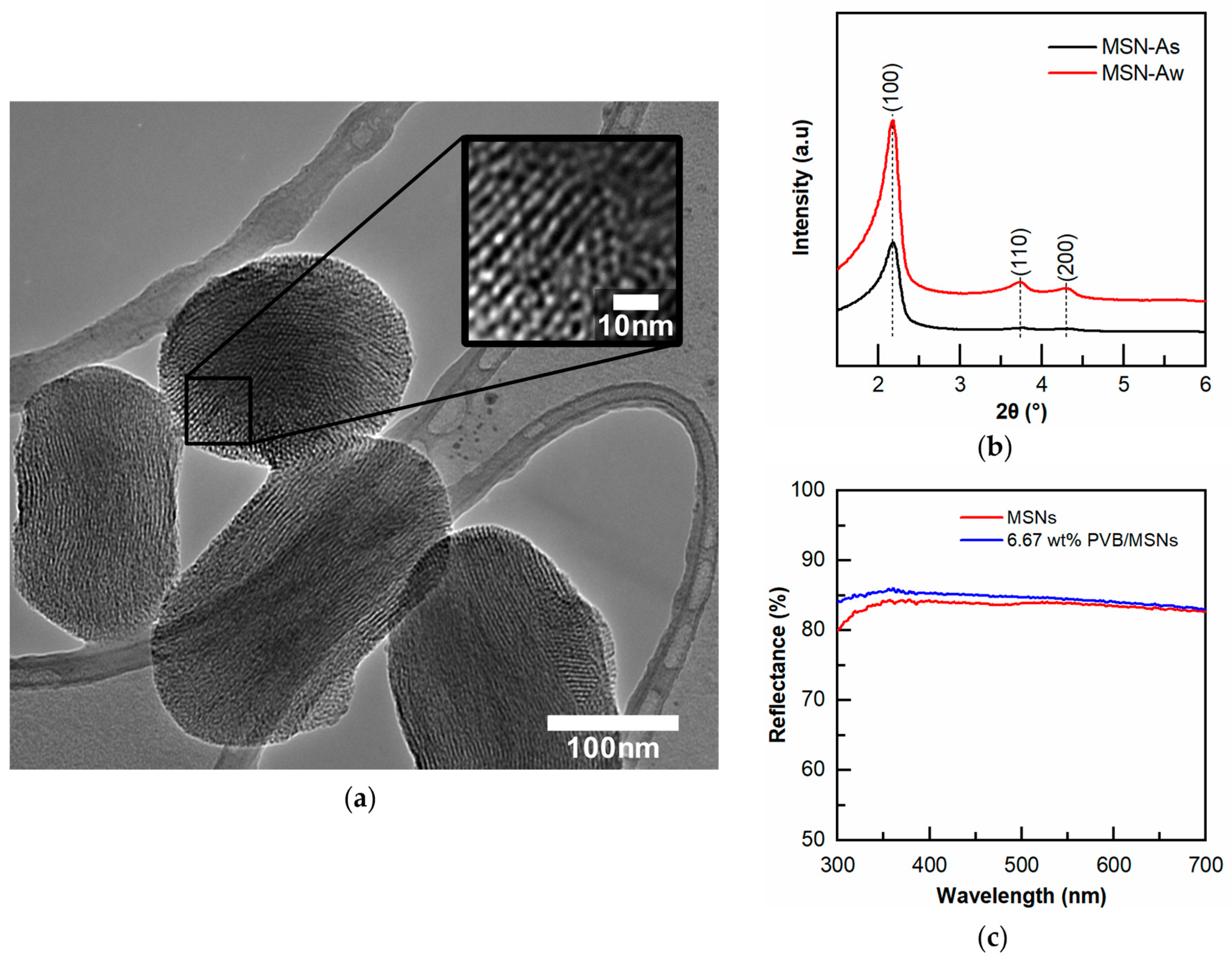
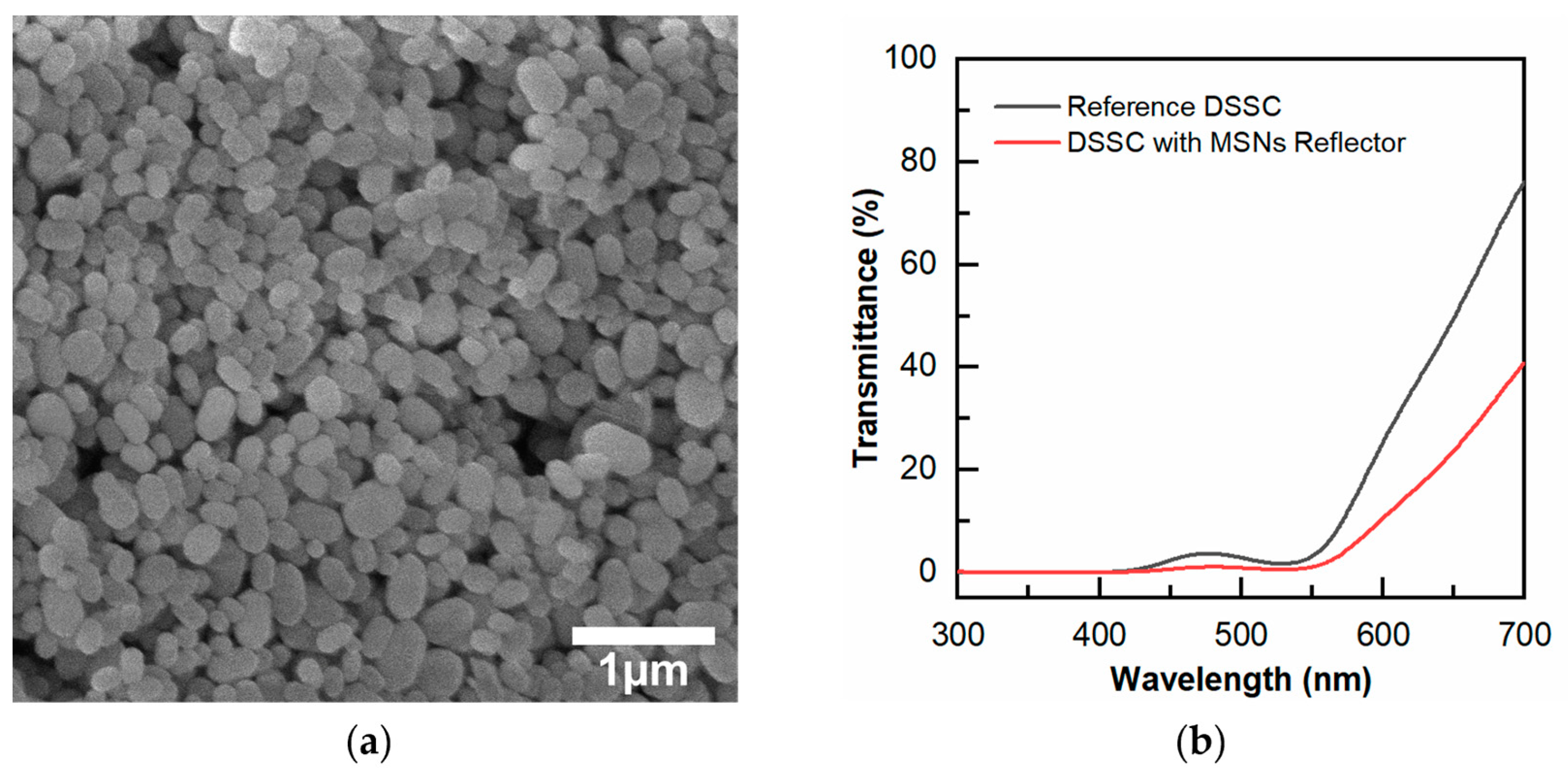
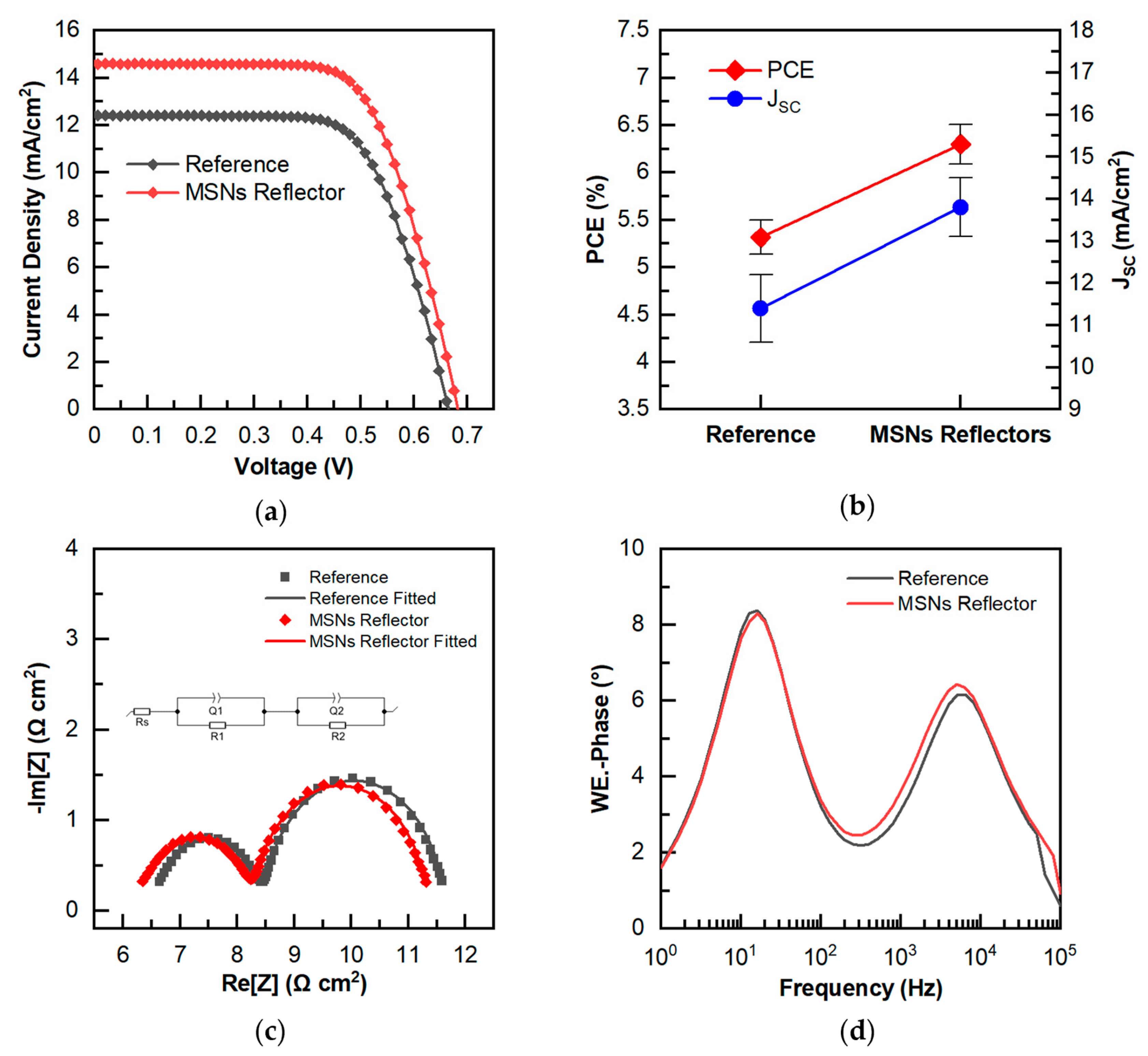
| Device Configuration | JSC (mA/cm2) | VOC (V) | FF | PCE (%) |
|---|---|---|---|---|
| FTO/c-TiO2/m-TiO2/N719/Electrolyte/Pt/FTO | 12.41 | 0.66 | 0.67 | 5.57 |
| FTO/c-TiO2/m-TiO2/N719/Electrolyte/Pt/FTO/MSNs | 14.60 | 0.68 | 0.67 | 6.68 |
| Device Configuration | R1 (Ω · cm2) | R2 (Ω · cm2) | Rs (Ω · cm2) | τ (ms) |
|---|---|---|---|---|
| FTO/c-TiO2/m-TiO2/N719/Electrolyte/Pt/FTO | 1.81 | 3.17 | 6.62 | 10.1 |
| FTO/c-TiO2/m-TiO2/N719/Electrolyte/Pt/FTO/MSNs | 1.93 | 3.09 | 6.30 | 10.1 |
Disclaimer/Publisher’s Note: The statements, opinions and data contained in all publications are solely those of the individual author(s) and contributor(s) and not of MDPI and/or the editor(s). MDPI and/or the editor(s) disclaim responsibility for any injury to people or property resulting from any ideas, methods, instructions or products referred to in the content. |
© 2023 by the authors. Licensee MDPI, Basel, Switzerland. This article is an open access article distributed under the terms and conditions of the Creative Commons Attribution (CC BY) license (https://creativecommons.org/licenses/by/4.0/).
Share and Cite
Fina, J.; Kaur, N.; Chang, C.-Y.; Lai, C.-Y.; Radu, D.R. Enhancing Light Harvesting in Dye-Sensitized Solar Cells through Mesoporous Silica Nanoparticle-Mediated Diffuse Scattering Back Reflectors. Electron. Mater. 2023, 4, 124-135. https://doi.org/10.3390/electronicmat4030010
Fina J, Kaur N, Chang C-Y, Lai C-Y, Radu DR. Enhancing Light Harvesting in Dye-Sensitized Solar Cells through Mesoporous Silica Nanoparticle-Mediated Diffuse Scattering Back Reflectors. Electronic Materials. 2023; 4(3):124-135. https://doi.org/10.3390/electronicmat4030010
Chicago/Turabian StyleFina, Jeffrie, Navdeep Kaur, Chen-Yu Chang, Cheng-Yu Lai, and Daniela R. Radu. 2023. "Enhancing Light Harvesting in Dye-Sensitized Solar Cells through Mesoporous Silica Nanoparticle-Mediated Diffuse Scattering Back Reflectors" Electronic Materials 4, no. 3: 124-135. https://doi.org/10.3390/electronicmat4030010
APA StyleFina, J., Kaur, N., Chang, C.-Y., Lai, C.-Y., & Radu, D. R. (2023). Enhancing Light Harvesting in Dye-Sensitized Solar Cells through Mesoporous Silica Nanoparticle-Mediated Diffuse Scattering Back Reflectors. Electronic Materials, 4(3), 124-135. https://doi.org/10.3390/electronicmat4030010








